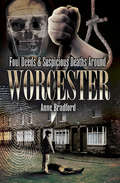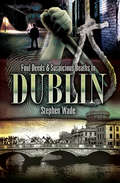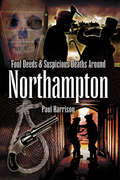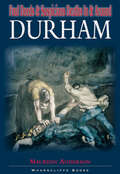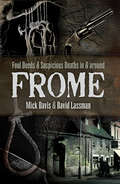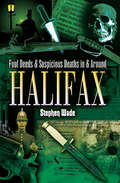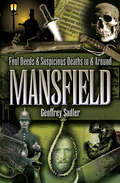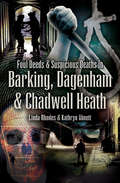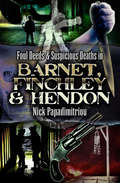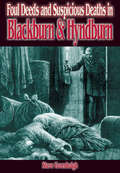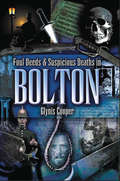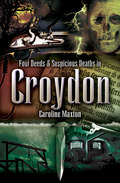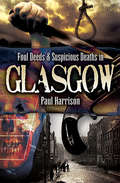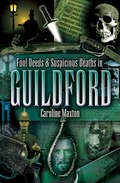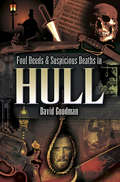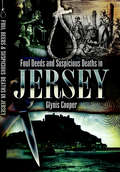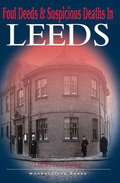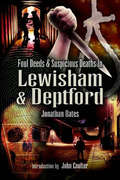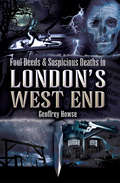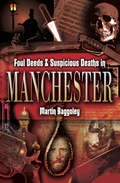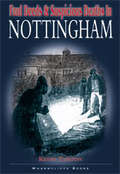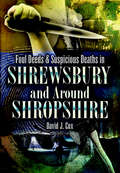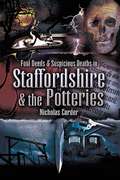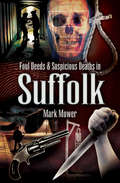- Table View
- List View
Foul Deeds & Suspicious Deaths Around Worcester (Foul Deeds & Suspicious Deaths)
by Anne BradfordTrue tales of betrayal, robbery, and murder across Worcestershire, from Redditch to Upton-on-Severn—includes illustrations and photographs! Though the Battle of Worcester brought an end to the English Civil War in 1651, it was not the end of the bloodshed for the West Midland county of Worcestershire. Known for its rolling hills and abundant farmland, it has also been fertile ground for thieves, murderers, and scoundrals of all sorts. Foul Deeds & Suspicious Deaths Around Worcester takes readers on a journey through centuries of sinister crimes, from the infamous to the stuff of local legend. Worcester&’s dark past goes back to the seventeenth century, when highwaymen haunted the surrounding forests. In this chilling volume, crime historian and Worcestershire resident Anne Bradford chronicles the county&’s history of forgery and betrayal, highway robbery and murder, riots and public executions. She also uncovers instances of domestic cruelty that resulted in death. From premediated crimes to desperate acts of passion, a range of human drama is covered in stories such as &“The Gentleman who Murdered his Mother,&” &“The Lovers&’ Pact,&” and &“Death of a Hop-picker,&” among others.
Foul Deeds & Suspicious Deaths In Dublin (Foul Deeds & Suspicious Deaths)
by Stephen WadeTory gangs, madmen, war criminals, frauds, anarchists, duelists, kidnappers, and more scandal-makers throughout four centuries of Irish history. Dublin is a wonderful, energetic cultural center—the pride of Irish achievements in architecture, arts, and literature. But it is also a city of paradoxes and conflicts—and a long, fascinating history of crime. Stephen Wade now reveals Dublin’s “strange eventful history” in this thrilling collection of murderers, thieves, daredevil highwaymen, libelers, seducers, and bloody avengers—from eighteenth-century turncoats to Victorian-era rogues to a twentieth-century parliamentary candidate with a killer past. Amid tales of sensational investigations and infamous courtroom trials, readers will discover the truth behind the disappearance of the Crown Jewels in 1907; the bizarre motives of nineteenth-century serial killer John Delahunt; and the startling charges leveled against Oscar Wilde’s father, a revolutionary doctor embroiled in a felonious and sexual cause célèbre of his own.
Foul Deeds & Suspicious Deaths around Northampton (Foul Deeds & Suspicious Deaths)
by Paul HarrisonTwenty true tales of violence and villainy in this area of England&’s East Midlands—includes illustrations. Foul Deeds and Suspicious Deaths Around Northampton investigates the darker side of humanity in cases of murder, deceit, and pure malice committed over the centuries in this picturesque part of England. For this journey into Northampton&’s bloody past, Paul Harrison has selected over twenty notorious episodes that give a fascinating insight into criminal acts and the criminal mind. He reinvestigates some of the most intriguing cases, introduces new evidence, and questions verdicts that were reached many years ago. Among the cases are two old people who were bludgeoned to death for no apparent reason; the murder of a mistress and her child; a philandering salesman who faked his own death; a promiscuous woman who came to a cruel end; a shoemaker who brutally attacked his wife; and the disappearance of Lydia Atley, whose remains were never found. These human dramas are often played out in the most commonplace of circumstances—while others are so odd as to be stranger than fiction.
Foul Deeds & Suspicious Deaths in & Around Durham (Foul Deeds & Suspicious Deaths)
by Maureen AndersonFoul Deeds and Suspicious Deaths in and Around Durham spans four centuries, with over fifty terrible tales of man's inhumanity to man, which are related in the pages of this book. In the early centuries superstition and ignorance were often the means by which justice was meted out. If it was believed that a crime had taken place, a person could be tried, condemned and hanged by the side of the road on nothing more than the statement of a neighbor. The nineteenth century saw the development of the coal industry. This brought thousands of impoverished men looking for work. Sadly , the wages were often spent on alcohol and women were often nothing more than punching bags for the drunken abusive husbands as is the case of Dorothy Wilthew who was murdered at Jarrow by her husband after years of abuse. Other cases include; Joseph Hutchinson who murdered his brother and father at Sedgefield later he was found to be insane, a child was kidnapped and later murdered by Isabella Thompson at Bishop Auckland and Maria Fitzmmons was found stabbed to death in Sunderland in 1869 it was to be 13 years before her killer, Thomas Fury, was convicted of the crime . Take a journey into the darker and unknown side of your area as you read Foul Deeds and Suspicious Deaths in and Around Durham.
Foul Deeds & Suspicious Deaths in & Around Frome (Foul Deeds & Suspicious Deaths)
by David Lassman Mick DavisThe Somerset town of Frome might top national polls as a great place to live and enjoy a reputation as the epitome of cool, with Hollywood A-listers regularly spotted on its street and global rock-stars playing its venues, but the place hasnt always been so chic and behind this modern-day faade lies a more sinister and foul past; full of murder, kidnapping, rioting, witchcraft and rebellion, among the other nefarious activities that have taken place over the centuries in the town and surrounding areas.Indeed, the very existence of Frome is down to acts of criminality; as it has been said the reason Saint Aldhelm built his Saxon church in the first place, thus bringing the market town into being, was to civilise the outlaws and bandits who roamed the interior of Selwood Forest; the huge tract of woodland which encircled the land that became the original settlement.Foul Deeds and Suspicious Deaths in and Around Frome chronicles fourteen foul but fascinating stories that includes the Frome vicar who wrote the most significant book on witchcraft, influencing everyone from The Great Beast himself, Aleister Crowley, to the perpetrators of the Salem witch trials; the key turning point in the Monmouth Rebellion; the last person to be publicly hanged outside Taunton gaol; a war veterans triple tragedy; and the violent and brutal pitched battle that was the culmination of a long-running feud between the local populace and the Salvation Army.You will never look at Frome the same way again.
Foul Deeds & Suspicious Deaths in & Around Halifax (Foul Deeds & Suspicious Deaths)
by Stephen WadeCalderdale has gone down in the annals of crime in England as the birthplace of Christie of Rillington Place, and as the haunt of the Yorkshire Ripper. But there is much more in the criminal history of the Halifax area to interest the reader with a taste for true crime. As a town with a shifting population of labour for the new mills of the Industrial Revolution, Halifax in the nineteenth century was a focus for urban disorder and lawbreaking. This book tells some of the tales from this period of social history, and from earlier times, when feuds and brutal punishment for crime were the order of the day.Here are the accounts of murders within the family, but also sad suicides and tragic assaults, public riots and violent vendettas. Every northern town has its darkunderbelly beneath the visible civic progress and commercial achievements Halifax and the cluster of towns nearby have had plenty of this nasty side of history, and these pages recount some of the most heinous and vicious crimes recorded between the anarchy of the Middle Ages and the dark twentieth century. The author, a graduate of Leeds University, is a social historian with a special interest in the chronicles of law and crime in the north. He has been a lecturer at the University of Huddersfield and has edited a number of books on literature and history with a regional context. He is currently working on Unsolved Yorkshire Murders, also published by Wharncliffe Books. He is planning to teach a course on the writing of crime in local history at the University of Nottingham.
Foul Deeds & Suspicious Deaths in & Around Mansfield (Foul Deeds & Suspicious Deaths)
by Geoffrey SadlerMidlands murders take center stage in a &“gripping&” book that &“chronicles some of Mansfield&’s most gruesome deaths over the past two centuries&” (Mansfield Chad). A young girl waylaid and battered with a hedge stake while returning home from Mansfield on a warm summer evening. Four family members butchered in a blazing house just off Commercial Street. An old farmer repeatedly speared by a hayfork in the mire of a rural farmyard. A drunken housewife found murdered in a haystack at Worksop, a razor killing and suicide on Nottingham Road, and the mysterious woman&’s skeleton discovered in the spoil of Sherwood Colliery tip. These, and other cases detailed here, show how often violent death has visited Mansfield and North Nottinghamshire in the past. Drawing on two hundred years of reported crime in Mansfield and the surrounding area, this account reveals the grim catalog of foul deeds, the variety of lethal weapons used—from a hedge stake to a mohair bootlace—and the age-old motives of greed, jealousy, forbidden desires, and thwarted love that have so often led men and women to murder.
Foul Deeds & Suspicious Deaths in Barking, Dagenham & Chadwell Heath (Foul Deeds & Suspicious Deaths)
by Kathryn Abnett Linda RhodesFoul Deeds and Suspicious Deaths in Barking, Dagenham and Chadwell Heath takes the reader on a sinister journey through centuries of local crime and conspiracy, meeting villains of all sorts along the way murderous husbands and lovers, cut-throats, police-killers, highwaymen, Gunpowder Plotters and even a Nazi collaborator sentenced to death for High Treason. Luckless individuals who came to cruel or unjust ends are also recalled, from martyrs and witches to the fishermen who perished in the Great Storm of 1863 and the passengers who lost their lives when the pleasure steamer the Princess Alice sank in the Thames in 1878. There is no shortage of harrowing and revealing tales of accident and evil to recount from the history of this part of Essex to the east of London. The human dramas the authors describe are often played out in the most commonplace of circumstances, but others are so odd as to be stranger than fiction. Their grisly chronicle of the hidden history of Barking, Dagenham and Chadwell Heath will be compelling reading for anyone interested in the dark side of human nature.
Foul Deeds & Suspicious Deaths in Barnet, Fincley & Hendon (Foul Deeds & Suspicious Deaths)
by Nick PapdimitriouStories of death and villainy will always hold us in their grim but thrilling grip. In Foul Deeds and Suspicious Deaths in Barnet the chill is brought close to home as each chapter investigates the dark side of humanity in cases of murder, deceit and pure malice committed over the centuries in this area of north London. For this journey into the sinister side of the past, Nick Papadimitriou has chosen over 20 notorious cases that give a fascinating insight into criminal acts and the criminal mind. Among the crimes he recalls are Elizabethan murders, highway robbery on Finchley Common, the violence of the Black-Hand Gang in Victorian times, the famous East Finchley Baby Murder of 1903, the Hendon Wine Shop Murder of 1919, the Edgware girl who was thrown under a tube train in 1939, and the shocking execution of murderer Daniel Raven in 1949.The human dramas Nick Papadimitriou describes are often played out in the most commonplace of circumstances, but others are so odd as to be stranger than fiction. His grisly chronicle of the hidden history of Barnet will be compelling reading for anyone who is interested in the dark side of human nature.
Foul Deeds & Suspicious Deaths in Blackburn & Hyndburn (Foul Deeds & Suspicious Deaths)
by Stephen GreenhalghFoul Deeds and Suspicious Deaths in Blackburn and Hyndburn examines 10 detailed murder cases that encompass the late Victorian period up until 1927. They are equally as gruesome and instructive as the better known cases that inhabit the pages of any number of true crime anthologies. All these tales of murder, suspicious deaths and foul deeds form part of the local history. Some of the cases were recorded nationally, whilst others have remained uncovered until now. The appalling social conditions that prevailed during the period of these crimes inevitably coloured the stories of the men, women and children who played their part in them.Take a journey into the darker side of your area and let your spine tingle, as you read Foul Deeds and Suspicious Deaths in Blackburn and Hyndburn.
Foul Deeds & Suspicious Deaths in Bolton (Foul Deeds & Suspicious Deaths)
by Glynis CooperThirty-two true crime stories from the history of the English town, from the sixteenth century to the early twentiethcentury.Foul Deeds and Suspicious Deaths in Bolton takes the reader on a sinister journey through centuries of local crime, meeting villains of all sorts along the way. There is no shortage of harrowing incidents of evil to recount from the town&’s early industrial beginnings to its murderous heyday in the nineteenth century. Glynis Cooper&’s fascinating research has uncovered grisly events and sad or unsavoury individuals whose conduct throws a harsh light on the history of a city that was once known as the Geneva of the North. These extraordinary stories, rediscovered in the Bolton Evening News, in council archives, and in police and court records, shed light on a bloody past that Bolton would prefer to forget.
Foul Deeds & Suspicious Deaths in Croydon (Foul Deeds & Suspicious Deaths)
by Caroline MaxtonTrue crime stories that span more than 200 years in south London history—from poisonings to passion killings. We are all drawn to understand the circumstances that lead others to commit unforgivable acts of violence—the moment that turns a caring human being into a killer, the series of events that drive ordinary people to murderous acts of inhumanity, or the slow, premeditated steps of the callous criminal. And the circumstances—and the twisted motivation—behind such violent acts are the subject of Caroline Maxton&’s fascinating investigation of individuals whose misdeeds have tarnished the history of the Croydon area. Maxton investigates a wide range of murders and unexplained deaths, some of which are truly stranger than fiction. The events cover a span of several centuries, and the locations will be chillingly familiar to the inhabitants of Croydon. Local crimes that hit the national headlines, like the Bentley case of 1952, are covered in fresh detail, but the author concentrates on less well-known but equally intriguing, and shocking, episodes: the bizarre &‘mustard and cress&’ murder of 1870, the brutal murder of Eliza Osborne in 1877, the Kenley Stud Farm mystery of 1922, the Birdhurst Rise poisoning of the late 1920s, and the notorious unsolved murder of eleven-year-old Miles Vallint of 1959
Foul Deeds & Suspicious Deaths in Glasgow (Foul Deeds & Suspicious Deaths)
by Paul HarrisonThe criminal cases vividly described by Paul Harrison in this gripping book take the reader on a journey into the dark secret side of Glasgow's long history. The city has been the setting for a series of horrific, bloody, sometimes bizarre incidents over the centuries. From crimes of brutal premeditation to those born of rage or despair, the whole range of human weakness and wickedness is represented here. There are tales of secret passion and betrayal, robbery, murder, gangland violence, executions, and instances of domestic cruelty and malice that ended in death. Among the fascinating and varied selection of cases Paul Harrison covers are an IRA ambush and gun battle, the policeman who murdered his lover, a Wild West-style shootout between police and a desperate robber, a sequence of horrendous serial murders including the case of Bible John, and the extraordinary acquittal of John Mitchell Henderson. The human dramas the author describes are often played out in the most commonplace of circumstances, but others are so odd as to be stranger than fiction. This grisly chronicle of the hidden history of Glasgow will be compelling reading for anyone who is interested in the dark side of human nature.
Foul Deeds & Suspicious Deaths in Guildford (Foul Deeds & Suspicious Deaths)
by Caroline MaxtonThe charming English town of Guildford is built upon centuries of mayhem and madness—from a Game of Thrones–style massacre to mysterious murders. The twin fascinations of death and villainy will always hold us in their grim but thrilling grip. In Foul Deeds & Suspicious Deaths in Guildford, the chill is brought close to home as each chapter investigates the darker side of humanity in cases of murder, deceit, and pure malice committed over the centuries in the area. From crimes of passion to opportunistic killings and coldly premeditated acts of murder, the full spectrum of criminality is recounted, bringing to life the more sinister history of Guildford and the surrounding villages.
Foul Deeds & Suspicious Deaths in Hull (Foul Deeds & Suspicious Deaths)
by David GoodmanHull is best known for its thriving port. The industrial revolution which profited Hull so well, came a a higher cost than most would expect. In only 100 years the population rose from 22000 to 239000. Houses were built quickly and close together, public health suffered dramatically and disease was rife.The vast population meant a very high level of crime. With almost one murder every other week, assaults, suicides and other acts of violence were so frequent that newspapers only reported the most vile of crimes. Victorian Hull was a very dangerous place to live indeed!David Goodman has put together a number of murders suicides and unsolved murders from 1873 through to 1924. Stories include: 'Murder on the Farm 1903'—Annie Marshall a 15 year old farm worker was shot twice in the face and dumped into the river by a fellow worker. 'Horrific Child Murder 1873'—Sarah Alice, only 4 months old was beheaded by her own mother after she failed to 'bond' with the child, she was found not guilty on the grounds of insanity and detained at her majesty's pleasure.
Foul Deeds & Suspicious Deaths in Jersey (Foul Deeds & Suspicious Deaths)
by Glynis CooperIn a superb companion volume to her best-selling book Foul Deeds and Suspicious Deaths in Guernsey, Glynis Cooper turns her attention to the dark side of the past in Jersey. And there is no shortage of shocking stories to tell—crimes of passion and despair, cases of murder, deceit and pure malice, opportunistic killings and coldly premeditated acts of wickedness that are as disturbing today as they were in their own time. For this journey into a neglected area in Jersey's history she has selected a revealing series of cases dating from the medieval period to the present day. She recalls the torture and execution of four female witches, the murderous outcome of a clash with Norman sheep stealers, a woman who married her husband's murderer and wreckers who preyed on Spanish treasure ships. And among the sensational episodes from more recent times are a schoolboy who raped a woman, the suicide of a jilted bride, the murder of French political refugees, a French general who was ruined by his lady love and corrupt officers who disgraced the Victorian police force.The human dramas Glynis Greenman describes are often played out in the most commonplace of circumstances, but others are so odd as to be stranger than fiction. Her fascinating account of Jersey's secret history will be compelling reading for anyone who is interested in the flaws in human nature.
Foul Deeds & Suspicious Deaths in Leeds (Foul Deeds & Suspicious Deaths)
by David GoodmanFoul Deeds and Suspicious Deaths in Leeds' is a collection of detailed accounts of foul deeds, usually murders, in the Leeds region during the period 1807–1926. The time period of 'Foul Deeds and Suspicious Deaths in Leeds' becomes a constant backdrop to the crimes committed. Many lived in cramped and over populated conditions. These appalling situations influenced some of the most notorious local crimes, which commanded the headlines at the time. 'Foul Deeds and Suspicious Deaths in Leeds' captivates crimes of passion in stark contrast to the seemingly calculated murders of Mary Bateman, known as the 'Yorkshire Witch'. The detailed approach to these individual cases tells us much about the people involved and how their lives were dramatically altered. Take a journey into the darker and unknown side of your area as you read 'Foul Deeds and Suspicious Deaths in Leeds'.
Foul Deeds & Suspicious Deaths in Lewisham & Deptford (Foul Deeds & Suspicious Deaths)
by Jonathan OatesThe twin fascinations of death and villainy will always hold us in their grim but thrilling grip. In Foul Deeds and Suspicious Deaths in Lewisham and Deptford the chill is brought close to home as each chapter investigates the darker side of humanity in cases of murder, deceit and pure malice committed over the centuries in this area of London. From crimes of passion to opportunistic killings and coldly premeditated acts of murder, the full spectrum of criminality is recounted, bringing to life the more sinister history of Lewisham and Deptford from the sixteenth century onwards. For this journey into the bloody, neglected past, Jonathan Oates has selected over 20 notorious episodes that give a fascinating insight into criminal acts and the criminal mind. The story of one of the most famous unsolved murders in history, of the great playwright Christopher Marlowe in Deptford in 1593. is followed by a catalogue of heinous crimes of every description—political conspiracies, gang killings, murders of policemen, suicide pacts, multiple poisonings, a husband who killed his wife and four children, the suicide of a crooked councillor, a motiveless murder and two unsolved murders that are as intriguing today as they were 80 years ago. The human dramas Jonathan Oates describes are often played out in the most commonplace of circumstances, but others are so odd as to be stranger than fiction. His grisly chronicle of the hidden history of Lewisham and Deptford will be compelling reading for anyone who is interested in the dark side of human nature.
Foul Deeds & Suspicious Deaths in London's West End (Foul Deeds & Suspicious Deaths)
by Geoffrey HowseLondon's West End is associated with fashion and glamour but for centuries it has had a far darker side. Geoffrey Howse has uncovered an astonishing catalogue of sinister deeds, some of them famous but others long forgotten. Read about spying, treason, embezzlement, regicide, robbery, forgery, religious persecution, suicide, murder and mutilation; and 'witness' horrendous punishments such as drawing, hanging, disemboweling, quartering, castration, beheading and burning. Earlier cases include the execution of Scottish patriots (1305/6) and three monks who dared to question the supremacy of Henry VIII in 1535. Such events attracted great public attention, as did the extraordinary execution of Charles I in 1649 and, in 1820, the hanging and mutilation of the Cato Street Conspiritors. The foul murder of the famous actor William Terriss, by a madman, in 1897, is featured as are several notable cases from the twentieth century including the horrific wartime murders of Gordon Cummins, the strange disappearances of the socialist MP Victor Grayson and Lord Lucan, the Charing Cross Trunk Murder as well as the mysterious death of boxer Freddie Mills.
Foul Deeds & Suspicious Deaths in Manchester (Foul Deeds & Suspicious Deaths)
by Martin BaggoleyMartin Baggoley was born in Eccles . He spent several years working in London and Salford as a civil servant, before qualifying as a probation officer in 1976. Since then, he has worked in the Greater Manchester area, and during this period gained a masters degree in criminology. He has written for a number of UK and American professional journals on criminal justice issues. His main interest is the history of crime and punishment and for this book, he has combind his professional experience and academic expertise with his interest in local history.
Foul Deeds & Suspicious Deaths in Nottingham (Foul Deeds & Suspicious Deaths)
by Kevin TurtonFoul Deeds and Suspicious Deaths in Nottingham' is part of the new established series by Wharncliffe Books. Covering the period 1830 –1950, the book examines murder and suspicious deaths in and around the city of Nottingham and what impact they had on the people of the city.Murder, mystery and suspicious deaths are often considered to be the province of the fiction writer. However, each story contained within 'Foul Deeds and Suspicious Deaths in Nottingham' is a true account of real events that had a serious impact upon all the lives of those involved. These are stories that once shocked, horrified and captivated, the people of Nottingham as they followed the unfolding events through the pages of the newspapers that hit their doormats each evening. From the strange and macabre to murder and mystery this book examines those cases. Analysing both motive and consequence alongside the social conditions prevalent at the time. It is a fascinating insight into a less well known period of Nottingham's past.Take a journey into the darker and unknown side of your area as you read 'Foul Deeds and Suspicious Deaths in Nottingham'.
Foul Deeds & Suspicious Deaths in Shrewsbury and Around Shropshire (Foul Deeds & Suspicious Deaths)
by David J. CoxSixteen true crime cases with a connection to two West Midlands English towns from the Middle Ages to the early decades of the twentieth century. Criminal cases give us a fascinating, often harrowing insight into crime and the criminal mind, into policing methods and the justice system. They also tell us much about social conditions and attitudes in the past. And such cases make absorbing reading. David Cox&’s graphic account of 16 notorious cases in Shrewsbury and around Shropshire is a particularly strong and revealing study of this kind. Using newspaper reports, census returns, and court records, he reconstructs each case in vivid detail. At the same time, he looks into the background of the crimes and into the lives of the criminals, and he describes the methods of detection and the punishments that were imposed. The cases he&’s chosen range in date from the medieval period to the twentieth century. Included are the case of the forger who had his ear nailed to a post, the father who killed his infant son with vitriol, the transportation of a seventy-year-old woman, the murder of an inmate in a lunatic asylum, a twentieth-century highway robber and a VC winner involved in bigamy. The personal dramas David Cox explores in this book will be compelling reading for anyone who is interested in the sinister side of human nature and human weakness.Criminal cases give us a fascinating, often harrowing insight into crime and the criminal mind, into policing methods and the justice system. They also tell us much about social conditions and attitudes in the past. And such cases make absorbing reading. David Cox's graphic account of 16 notorious cases in Shrewsbury and around Shropshire is a particularly strong and revealing study of this kind. Using newspaper reports, census returns and court records, he reconstructs each case in vivid detail. At the same time he looks into the background of the crimes and into the lives of the criminals, and he describes the methods of detection and the punishments that were imposed. The cases he's chosen range in date from the medieval period to the twentieth century. Included are the case of the forger who had his ear nailed to a post, the father who killed his infant son with vitriol, the transportation of a 70-year-old woman, the murder of an inmate in a lunatic asylum, a twentieth-century highway robber and a VC winner involved in bigamy. The personal dramas David Cox explores in this book will be compelling reading for anyone who is interested in the sinister side of human nature and human weakness.
Foul Deeds & Suspicious Deaths in Staffordshire & the Potteries (Foul Deeds & Suspicious Deaths)
by Nicholas CorderIn Foul Deeds and Suspicious Deaths in Staffordshire and the Potteries the chill is brought close to home as each chapter investigates the darker side of humanity in notorious cases of murder, deceit and pure malice that have marked the history of the area. For this journey into a bloody, neglected aspect of the past, Nicholas Corder has selected over 20 episodes that give a fascinating insight into criminal acts and the criminal mind. Recalled here are the Rugeley poisoner William Palmer, who disposed of his victims with strychnine, the vicious assaults on Issac Brooks and the miscarriage of justice that put George Edalji behind bars for three years and brought the creator of the world's greatest fictional detective to his rescue. The Canal boat killing of poor Christina Collins is described in graphic detail, as is the sad case of Thirza Tunstall's baby and the bizarre case of the headless corpse of Hednesford. The human dramas Nicholas Corder explores are often played out in the most commonplace of circumstances, but others are so odd as to be stranger than fiction. His grisly chronicle of the hidden history of staffordshire and the Potteries will be compelling reading for anyone who is interested in the darker side of human nature.
Foul Deeds & Suspicious Deaths in Suffolk (Foul Deeds & Suspicious Deaths)
by Mark MowerTrue stories of real-life British mysteries and murders going back centuries—photos included. This book tells stories of murder, deceit, and pure malice committed over the centuries in this traditionally rural part of East Anglia in England. From crimes of passion to opportunistic killings and coldly premeditated acts of murder, the full spectrum of criminality is recounted here. In this collection of grisly crime stories, Mark Mower takes us on a journey through the darker side of Suffolk folklore, with tales of poisoning, grave robbing, stabbing, shooting, and larceny. On the way we meet highwaymen, cut-throats, murderous lovers, homicidal relatives, pirates, and purveyors of human flesh. The dramas he describes are often played out in the most commonplace of circumstances—while others are so odd as to be stranger than fiction.
Foul Deeds & Suspicious Deaths in Wigan (Foul Deeds & Suspicious Deaths)
by Mike FletcherFoul Deeds and Suspicious Deaths in and Around Wigan is a detailed guide to the town's darker side, exploring, often in gory detail, Wigan's more sinister heritage, by examining accounts of murder and suspicious deaths from the middle ages through to the twentieth century. Victorian Wigan was a town seemingly overflowing with criminals, and some of the most gruesome cases, recounted from the reports taken from the Wigan Observer and Wigan Examiner, occurred in the second half of the nineteenth century. Many of the cases are without motice or provocation. Domestic crime features highly, often involving Wigan's colliers savagely beating their wives to death, and some of the cases remains unsolved. Each of the cases are covered in detail, documenting the crime, the investigation and inquest, and culminates with the eventual court case and punishment.
